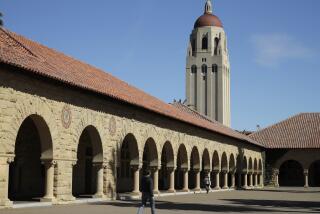For-profit colleges face federal crackdown
Chelsi Miller was managing a burger joint when she saw an ad for Everest University promising a better life.
The single mother in a small town near Salt Lake City wanted an associate’s degree as a first step toward medical school. She said she chose Everest, a for-profit college, after a recruiter guaranteed that she could apply her credits toward a higher degree at the University of Utah.
It wasn’t until after she graduated in 2008 — two years and $30,000 in student loans later — that Miller learned the state university wouldn’t take her credits from Everest, a unit of Santa Ana-based Corinthian Colleges Inc.
“I got completely taken advantage of, and now I’m struggling to pay the bill for it,” said Miller, now 26. “I got sold my degree by a used-car salesman. I got a lemon.”
For-profit colleges have expanded rapidly in recent years, with enrollment nearly tripling in a decade to more than 1.8 million students in 2008. But amid growing criticism of its high-powered marketing and doubts about the value of the degrees it offers, the industry faces a federal crackdown that casts a shadow over its future.
“Rightly so, the industry is going to have to shift focus” from maximizing profits to ensuring student success, said Jeff Silber, an analyst at BMO Capital Markets. “That means slower growth and less profitability.”
Among the companies most vulnerable to stiffer rules is Corinthian, which already has undergone wrenching changes. Its chief executive and president both quit last fall, and the firm last week warned that its enrollment of new students, already on the decline, could plunge further. Its stock has slumped 75% since April.
The for-profit industry caters to nontraditional students — 20-somethings with poor academic records and working adults needing flexible class schedules. But the schools lure such students, critics say, by exaggerating their job and salary prospects, then strand them with dubious educations and mountains of debt.
“We’re seeing too many examples where students go deeply into debt and either end up with no diploma or a worthless diploma,” Sen. Richard J. Durbin (D-Ill.) said. “It is a terrible outcome for a student who was just trying to get an education.”
High tuition
Tuition is nearly five times as high at two-year for-profit colleges as at state schools. At four-year for-profit colleges, half of graduates leave school with at least $31,000 in student loans. That’s nearly four times that of their public-university counterparts, studies show.
For-profit students borrow heavily, receiving 24% of government-guaranteed student loans while accounting for only 12% of U.S. college students. But many graduates say they can’t get jobs in their chosen fields, and certainly can’t earn enough to whittle down their debt.
One in four students at for-profit colleges default on their loans within three years, more than double the rates at state schools and private colleges, the U.S. Department of Education says.
Defaults can stay with students forever. Student-loan debt can’t be erased by filing for bankruptcy, and collectors can seize money from a borrower’s paycheck, tax refund and even Social Security benefits.
Sen. Tom Harkin (D-Iowa), who has spearheaded the federal crackdown, likens the industry to the subprime mortgage business.
“Subprime lenders went out and marketed houses to people who really couldn’t afford them, gave them subprime loans and said, ‘Don’t really worry about it,’” Harkin said.
“At least in the subprime debacle the defaulter could walk away from the house and leave the house. These students have this debt on their head forever.”
High-pressure sales tactics laced with false promises are the core abuses that critics ascribe to for-profit higher education.
An investigation of 15 for-profit colleges by the congressional Government Accountability Office last year found widespread problems, including inflated salary projections and misleading tuition information. One school told an investigator posing as an applicant that barbers could earn $150,000 to $250,000 a year.
At Corinthian, recruiters are taught to convince students that their lives are bad and can be improved only by going to the school, according to a former recruiter.
“The ultimate goal was to essentially make them wallow in their grief, feel that pain of having accomplished nothing in life, and then use that pain” to coax them to enroll, the recruiter, Shayler White, testified in an affidavit in a lawsuit filed against Corinthian by Miller and other ex-students.
The schools, accusing critics of overstating the problems, say job-placement and default rates have suffered in the recession.
Filling a niche
Corinthian in particular says it fills a crucial niche by taking troubled students, many of them minority and low-income, whom traditional colleges can’t or won’t accept.
“We deal with the most difficult students in American education, and as a result we get criticized,” said Jack Massimino, Corinthian’s chairman and chief executive.
“At the end of the day these students are graduating and getting opportunities they’ve never had before. The world’s passed these students by, and we’re giving them a second chance.”
A showdown is looming over a Department of Education proposal that would limit the loan eligibility of a school’s current students if the salary levels and repayment rates of its former students are too low.
Supporters say the “gainful employment” rule would ensure that students get marketable skills and decent jobs. The industry says it could prevent needy students from getting degrees.
Corinthian also is scraping up against a federal rule that caps the percentage of a school’s revenue that can come from federal student loans and grants at 90%. Corinthian is at 89%.
Given the heavy reliance by Corinthian and other schools on federal money, industry critics express outrage that the industry is lobbying against the rule.
“They’re using federal funds to buy advertising to stop federal regulation of the abuses in their industry,” Durbin said. “It’s a shameful situation.”
Underlying the debate about for-profit schools is the belief among even some critics that they must play a big role in the education system given cutbacks at public universities and community colleges.
“We cannot reach the needs we have in California without a for-profit sector,” said William Tierney, an education professor at USC.
Tierney acknowledges flagrant violations at some for-profit colleges but says cases of excessive debt and low employability exist in traditional education as well.
“I should not be paying tax dollars for somebody to get a degree as a dishwasher because he doesn’t need it,” Tierney said.
“But why doesn’t that hold for everybody? Why wouldn’t that hold for the person who’s accumulating $100,000 in debt and majoring in philosophy at Stanford?”
Heavy advertising
Corinthian, one of the nation’s largest for-profit chains, was founded in 1995 and expanded via 18 acquisitions. It has more than 100,000 students at 110 campuses in 25 states and Canada under three nameplates — Everest, Heald and WyoTech. Focusing on career training, it offers courses in auto repair, healthcare and paralegal studies. Most of its programs are two years or less.
The company advertises heavily, with 20% of its revenue going to pay for marketing and admissions in fiscal 2010. Many of its TV commercials feature testimonials by students.
In one ad running now, a single mother says she’s proud to have graduated.
“If she can do it, you can do it,” an announcer intones. “Pick up the phone and call right now, and start on the road to a rewarding career and a better life.”
Yet 40.3% of Corinthian students default on their loans, according to calculations by Jarrel Price at Height Analytics. That dwarfs even the overall for-profit industry’s 25% average, let alone the much lower rates for nonprofit schools.
“For one in four students to be defaulting is astonishing enough, but for 40% of a school’s former students to be defaulting calls out for immediate action,” said Pauline Abernathy, vice president at the Institute for College Access and Success.
Corinthian says it has boosted efforts to help students find jobs and avoid defaults. It hired 250 career counselors during the recession, bringing the total to 750. And it spent $10 million last year to help students avoid default.
About 60% of Corinthian’s students complete their coursework and 73% got jobs in their field in 2009, according to the company.
“I’m not telling you we’re perfect — we do make mistakes,” Massimino said. But “it is in our best interest to do a good job. We’re trying to do the best job possible.”
Negative publicity
This is not the first time Corinthian has come under a harsh spotlight.
Four years ago, it paid $6.5 million to settle a lawsuit by the California attorney general’s office alleging that the company used misleading come-ons to recruit students, including exaggerating job-placement rates and starting salaries.
The company also late last year stopped accepting students without high school diplomas because of their above-average default rates.
That move, along with negative publicity about the industry, caused the number of new students enrolled by Corinthian to sink 8% in the fourth quarter from a year earlier.
Warning that new enrollment could tumble as much as 17% in the current quarter, Corinthian said last week it would eliminate 4% of its workforce and raise tuition an average of 12%.
To former Corinthian students such as Wendy Cogdill, reforms can’t come quickly enough.
The 41-year-old substitute mail carrier said she got straight A’s in her quest to become a paralegal. But three years after completing her classes, the Conyers, Ga., mother of three hasn’t found a job in her field and is groaning under $40,000 in debt.
She believes that the system is designed to divert students’ attention from the debt they’re accumulating. Corinthian handled all her loans and gave evasive answers when she asked for details, Cogdill said.
“They don’t tell you how much you’re borrowing until after the fact,” she said. “I had no idea that after graduating I would be $40,000 in debt.”
In some ways, Miller, the aspiring doctor, is doing better than other Corinthian alumni. She landed a job as a surgical technician shortly after graduating but says she got it only with the help of a friend’s mother and can’t advance unless she starts college all over.
Miller and two other former students have sued Corinthian, alleging that they were misled about accreditation and tuition.
Corinthian says it clearly discloses tuition and accreditation issues. For example, the company says it makes every new student sign a form that says credits generally can’t be transferred to other colleges or universities.
“There is no hide the ball here,” Massimino said.
Despite her frustration with Corinthian, Miller recognizes that the school’s statistics will count her as a graduate working in the field she studied.
“I’m a success story to them,” she said.






